The Land Of China -- Explore by Province
Hubei
Hubei runs along the middle reaches of the Yangtze River, north of Dongting Lake. Covering an are of 18,590,000 square kilometers, it has a subtropical monsoon climate. With a population of 57,188,100, its main ethic groups include Hanzu, Tujia, Miaozu, Huizu, Dongzu, Manchu, Zhuangzu, and Mongol. The capital city of Hubei is Wuhan.
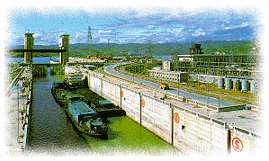 Hubei
Hubei
|
Since ancient times, Hubei has been a well-developed area both in economy and in culture due to its superior, central location. For those who love natural beauty, Hubei has green carpets of rice fields, clear lakes, blossoming cherry flowers in its east part, and wild mountains with primitive forests, caves, and cool fountains in its western part. If you are more interested in historic events, travelling along the Yangtze will let you enjoy sights of ancient war sites and hear heroic stories of the ancient generals and warriors and martyrs of the republican revolution led by Dr. Sun Yat-sen.
Hubei boasts both beautiful scenery and historical artifacts. The best-known natural scenery is the Three Gorges of the Yangtze River. Wudang Mountain and Jiugong Mountain are the sacred places of Taoism. Shennongjia is an important natural preserve, attracting attention from the world not only because of its rare species but also because of the mystery of the Apemen. Hubei's historical ruins include Emperor Yan's Temple in Suizbou, the hometown of Quynan in Zigui and of Zhaojun in Xingshan, the ancient city of Jinan, Guqintai in Wuhan, the Yellow Crane Pavilion, the Red Cliff in Puqi from the Three Kingdoms' period, the site of the government of the Wuhan revolutionary army, and the Museum of the Erqi Strike of the Beijing Hankou Railway Workers. These sites allow tourists to learn of many significant events in China's history.
Most tourists reach the capital city, Wuhan. Driving downtown through a modern city's hustle and bustle, don't forget that this city dates back to the 11th century B.C. during the period of the Shang Dynasty (16th century B.C.- 11th century B.C.). It was ruled by the Kingdom of Chu during the Spring and Autumn Periods and later by the Kingdom of Wu during the Three Kingdom Period (220-280). In 1911, the Republican Revolution, led by Dr. Sun Yat-sen, won a most important victory here against the Qing rulers. Having been an important port for 2000 years, Wuhan is now China's 5th largest city and is also a cultural center with a large number of universities and institutes.
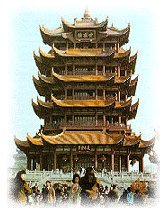 the Yellow Crane Tower
the Yellow Crane Tower
|
The Yellow Crane Tower was built atop Sheshan (the Snake Hill) of the Wuchang district along the Yangtze River. Acclaimed as an ancient historical site and scenic wonder, it is one of three famous towers south of the Yangtze River. Destroyed many times by fire, it was rebuilt in 1981 and completed in June 1985, when it was opened to the public. Reconstructed according to a picture from the Qing Dynasty, the tower has five stories and rises 51.4 meters. Covered with yellow glazed tiles and supported with 72 huge pillars, it has 60 upturned eaves, layer upon layer. Looking at the tower from any vantage point, one will see the same scene. Its interior decor is antique, but the tower has adapted to modern needs as it is equipped with air-conditioning and an elevator.
 the Yangtze River Bridge
the Yangtze River Bridge
|
The Yangtze River Bridge links the Snake Hill in Wuchang to the Turtle Hill in Hanyang. It was the first steel bridge ever to be built across the mighty Yangtze River. Including the approaches of 303 meters to the north and 211 meters to the south, it is 1,670 meters long and has eight piers with nine arches. Below the motorway on the bridge, there is a double-track railway that is 14.5 meters wide. Construction of the bridge started in September 1955 and was completed in October 1957. From the river bed to the motorway surface, it is 80 meters in height. At each end of the bridge, there is a tower 35 meters high, installed with a lift. The motorway is 18 meters wide and contains six lanes.
Those who have read the novel "Romance of the Three Kingdoms" will find Chibi (Red Cliff) on the Yangtze, which is an exciting war site. This is where, in the year of 208, the hree kingdoms engaged in a fierce fight. Admirers of Zhu Geliang will naturally visit Longzhong, where the wise strategist farmed and read untill Li Bei, later King of the Shu Kingdom, visited him three times in order to invite him to be his adviser
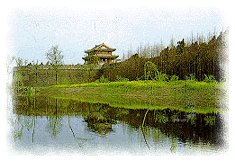 Jingzhou
Jingzhou
|
Jingzhou has been a place of strategic importance contested by many throughout history. In 689 B.C., the Kingdom of Chu moved its capital to the city of Yingdu (i.e. The city of Jinan, five kilometers north of the ancient city Jingzhou). During the Three Kingdom Period (220-280), fierce battles were fought here. It is said that the ancient city wall was built by Guan Yu some 1,700 years ago and that the present wall was built in 1644. Polygonal in shape, it is 8.3 meters high, 10 meters thick and 10.5 kilometers long with six city gates. For defense, it has an earthen wall inside the city and a moat. Intact and well-preserved, this is the only wall of its kind in southern China. Within the city are many cultural relics, including 700 mausoleums and thousands of small tombs containing the descendants of the Chu Kingdom. There are also many historical relics of the Three Kingdoms.
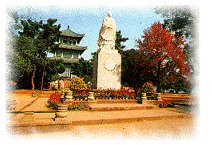 East Lake
East Lake
|
The East Lake is located in the eastern suburbs of Wuchang. It is one of 10 lakes located in an 87-square kilometer area and contains 33 square kilometers of water. It is a key scenic spot protected by the state. At present it holds three scenic areas, Tingtao, Moshan, and Luohong, which are open to the public, and three more are being developed. Being a vast lake full of bays and gulfs, it is known as "the Lake of 99 Bays." Its main scenic spots are Jiunudun, the Chu Emperor's Tomb, and Cao Cao Monastery.
The Chinese Sturgeon Aquarium is situated on the islet of Xiaoxita in Yichang County. Built in 1982, it is an institute for the artificial breeding of Chinese sturgeon. The Chinese sturgeon have been around for over 140 million years, and therefore have coexisted with the dinosaurs. The aquarium is given first class state animal protection. The fish can grow to four meters in length and to 500 kilograms in weight. Known as the 'King of Fish' in the Yangtze River, the Chinese sturgeon are the biggest of the 27 species of sturgeon in the world. The fish often swam to the upper reaches of the Yangtze to spawn and carried their fry back down to the lower reaches. However, the damming of the river blocked such a passage for the fish. After years of effort, success has been achieved in the breeding at the aquarium.



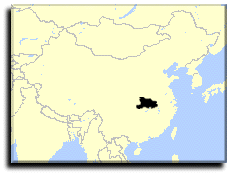









 Chinese Culture
Chinese Culture